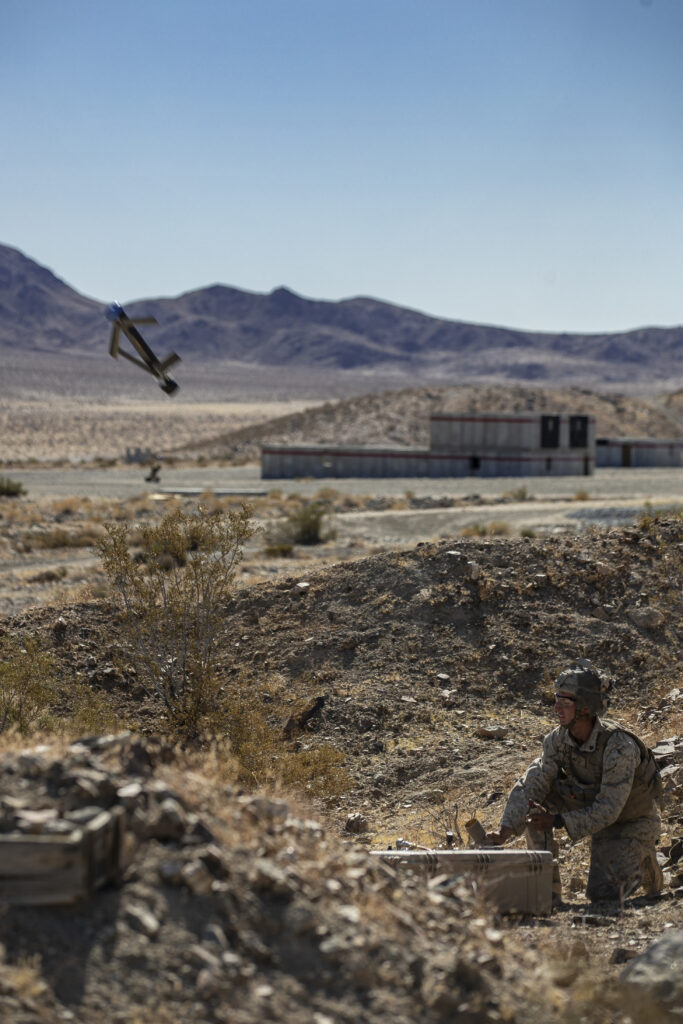
A Marine launches the Switchblade 300, a weaponized Small Unmanned Air System
WASHINGTON: The Marine Corps are looking for new loitering suicide drones that troops can launch while on the move, listing them as its number one acquisition priority.
The two systems came in at the top of a list of equipment the service wants as it builds new light battalions to operate in small, dispersed groups on Pacific island chains.
The list came at the conclusion of the Corps’ latest version of its Force Design 2030 document. It outlines some of the major muscle movements ordered by Commandant Gen. David Berger to make the force lighter, faster, and better to support the Navy in a contest with the Chinese. The new list was released today,
In November, the Corps asked the defense industry for help in developing what it called an “Organic Precision Fires-Infantry,” a portable tube that can launch a small drone capable of loitering for up to 90 minutes at a range of about 12 miles, and capable of “swarming” with other drones.
The Corps is also looking for “Organic Precision Fires-Mounted” munition — another loitering drone — which would be launched from a Light Armored Reconnaissance (LAV) or similar vehicle, which would partially replace many of the 120mm mortars the service has decided to get rid of.
The systems fit in with the emerging Marine Corps plan to become lighter, faster, and more precise after its troops spending the past two decades operating out of fixed bases in Iraq and Afghanistan, acting more as traditional infantry than an expeditionary force designed to rapidly kick open doors at the outset of hostilities.
The new document goes a long way in putting reconnaissance at the top of the Corps’ job responsibilities, and the loitering drones make sense when put in the context of the direction the Marines are heading, which was most fully outlined in another recently released document, the Tentative Manual For Expeditionary Advanced Base Operations.
That paper lays down the broad outline for how the Corps plans to build the capability to establish a series of small, ad hoc bases on remote islands from which to launch missiles and refuel and resupply troops on the move. It calls for precision long-range missiles to sink ships from shore, and new classes of manned and unmanned ships to both shoot and quickly ferry troops and supplies amid contested islands.
When it comes to the mounted drone launcher however, it might have to wait until the Marines come up with a new vehicle, as the Force Design 2030 paper points out that its work has “invalidated the requirement to replace existing LAV-25s with a similar armored, wheeled or tracked manned vehicle” — leading the Corps to come up with new ideas for how to ferry its troops around once they hit shore.
The work done over the past year has led leadership to begin to start building what it’s calling a “multi-domain Mobile Reconnaissance unit” that would feature “light-weight vehicles, unmanned air and surface systems, boats, and other capabilities necessary to succeed in a contested information environment.”
Some kind of Advanced Reconnaissance Vehicle would replace the older LAVs in these units, but Marine leaders aren’t sure what that might look like yet even though they kicked off LAV replacement studies in early 2019.
“What it will be replaced with is not another vehicle per se,” Lt. Gen. Eric Smith, head of the Corps’ Combat Development office told reporters on a recent call. “The capability to control air and ground robotics and to provide reconnaissance — what form that takes is still unknown, that’s what we’re experimenting and wargaming with,” he said.
Brig. Gen. Eric Austin, the Capabilities Development Directorate chief, added that “the ARV is not a LAV: it is a platform. It is an open-architecture, payload-agnostic platform largely that we’re going to have platform-agnostic payloads on that are going to enable us to sense, make sense, [command and control], quarterback, do other things with.”
Navy jet trainer fleet operations remain paused after engine mishap
One week after the incident, a Navy spokesperson says the service is continuing to assess the fleet’s ability to safely resume flight.


























